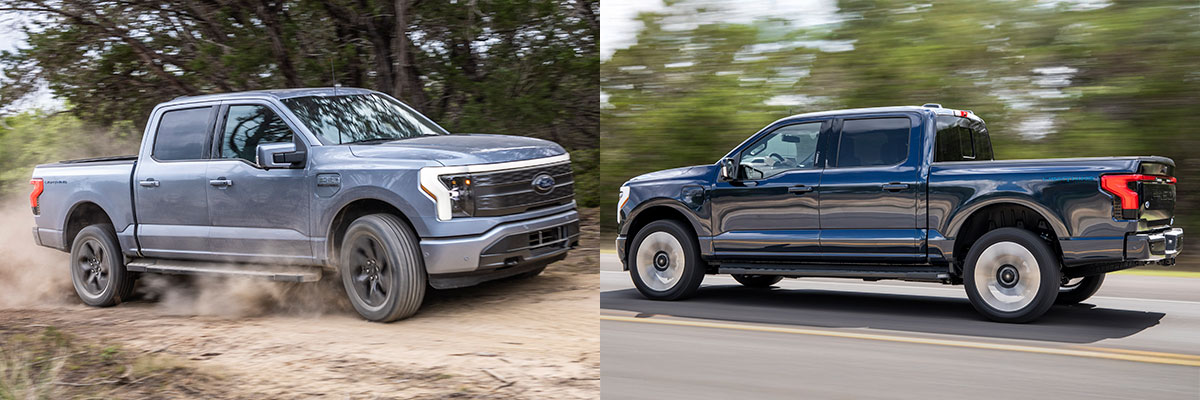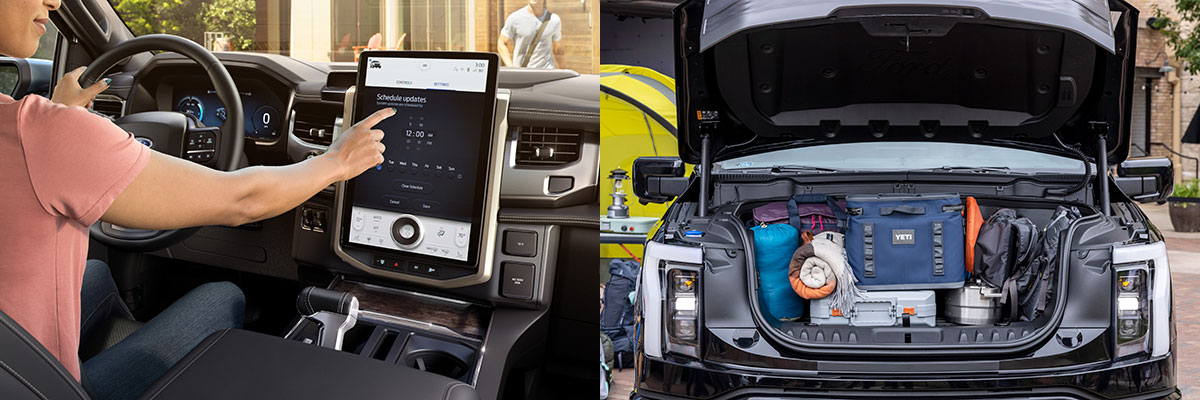2025 Ford F-150 Lightning
Just because it is electric, doesn't make it less of a truck. In fact, it's more.
Despite claims by other automakers, the Ford F-150 Lightning was actually the first all-electric pickup to hit the market when it arrived on the scene in 2022 - forgetting of course the somewhat unsuccessful Chevrolet S-10s and Ford Rangers pf the late 1990s. Helping Ford get production going first was the fact that the Lightning is based on the existing F-150. Offered only as a 4-door SuperCrew with 5.5-foot bed, the all-electric Lighting's most intriguing features include a front trunk and the ability to reverse charge in the event of a power outage. Its competitors include the Chevrolet Silverado EV, GMC Sierra EV, Rivian R1T, and Tesla Cybertruck.
The 2025 F-150 Lightning is available in five trims: Pro, XLT, Flash, Lariat, and Platinum. It features dual-motor all-wheel drive as standard across all trims, with two battery options-standard-range and extended-range-offering an EPA-estimated range of 240 to 320 miles, depending on the configuration. Charging times range from approximately 13 hours on a Level 2 charger to 38 minutes on a 350-kilowatt DC fast charger. The Pro and XLT trims have the standard-size battery pack and 452 horsepower and 775 lb-ft of torque. The larger battery pack comes fitted to the Flash, Lariat and Platinum. Horsepower rises to 580 with the bigger battery. The truck boasts a towing capacity of up to 8,600 pounds on higher trims equipped with the Max Trailer Tow Package, making it a capable workhorse.
Pricing for the 2025 F-150 Lightning starts at $62,995 for the XLT trim and goes up to $84,995 for the Platinum trim. Available safety features include BlueCruise 1.4 hands-free driving assistance, a 360-degree camera, and trailer backup assist. Optional packages, such as the Max Trailer Tow Package and the new Dark Elements Package, allow buyers to customize their trucks with enhanced towing capabilities or unique aesthetic upgrades. These features ensure the F-150 Lightning remains a competitive and versatile option in the electric truck segment.

Though the F-150 Lightning is a very heavy truck, it accelerates quite briskly. Platinum models will zip from 0 to 60 MPH in a scant 4 seconds and trip the quarter miles trap in just 12.7 seconds. Expect base models with the smaller battery pack to be slightly slower, but still quite impressive given the 6,000-plus-pound curb weight. As is the case with most EVs throttle response off the line is immediate and mid-range passing punch is exceptional. Once up to highway speed, acceleration is somewhat less impressive, but still quite good.
Since there is no transmission, there's no shift shock. All models get all-wheel drive. However, it is through the road all-wheel drive, meaning there is no connection between the front and rear axle. Still, though computers, power is directed to the wheels with the most traction and the brakes can be applied to limit wheel spin. There's also no 4WD low range, however, the electric motors provide maximum torque at all speeds, so the Lighting has plenty of power for off-roading.
As stated, EPA range is 240 miles with the smaller battery and 320 with the larger battery. However, that's best-case scenario. Warm and cold weather will negatively affect that range. Charge speeds on wall plug are about 3 miles per hour. At a Level 2 charger, speeds increase to between 15-30 miles per hour. At a DC fast charger, Ford claims F-150 Lighting can go from 15 to 80 percent in about 45 minutes.
Handling isn't the strong suit of any pickup, and the Lightning is no exception. In sharp turns and quick transitions, the sheer size and weight of Lighting quickly reminds drivers to slow down. And though the battery pack is placed fairly low -- creating a lower center of gravity -- it has so much mass that it dulls agility in changes of direction. Steering is typical pickup-truck numb, but at least it is accurate, and the Lightning doesn't wander on the highway. Brakes have a somewhat artificial feeling in hard stops but feel quite natural most of the time.
Because F-150 Lightning is an EV, Ford was able to program it with "one-pedal" driving. When selected, this mode allows drivers to all but forget about the brake pedal and modulate speed by varying pressure on the accelerator. Lift off the throttle a bit and Lightning slows like a traditional gas vehicle, lift all the way and it slows as if you pressed the brakes. This is designed to maximize energy recapture during braking and helps to extend range. Though there's a learning curve, one-pedal mode quickly becomes second nature, and you end up almost never using the friction brakes.
Another feature available in Lighting is Ford's Blue Cruise semi-autonomous driving system. Like the system found in General Motors products, Blue Cruise allows the driver to take their hands off the steering wheel when activated and but only be used on registered highways. In practice Blue Cruise works very well to maintain lane centering and appropriate speeds, even in stop-and-go driving. Still, it is not perfect. Under the right lighting conditions is does not recognize the driver's eyes and constant warns to take over driving. In addition, in merge situations, it warns to have the driver take over.
Because F-150 Lighting is electric, it's very quiet. There's a mild hum in acceleration, but otherwise the electric motors are whisper quiet. Around town, road and wind noise are nicely quelled and there's only a hint of wind rush at extra-legal highway speeds.

Much like the regular F-150, the Lightning interior is cavernous, and the layout is intuitive and well organized. Materials vary depending on trim level but are always sturdy and price appropriate. The front seats are comfortable and supportive and can be equipped with heating, ventilation, three-level lumbar adjustment and even a massage function. They can also recline to near flat so occupants can take a nap while charging (not sure this is such a great idea). The rear seating area is positively huge with plenty of space for three full-size adults. The interior is also quite versatile, incorporating the fold-down shifter that allows for a center-console workspace.
On the tech side Lightning has it all. The highlight is undoubtedly the available 15.5-inch center touchscreen. Wireless Apple CarPlay and Android Auto smartphone integration are standard, and Ford's onboard navigation system is responsive and cleanly designed. An additional bonus of the navigation system is that it can help find EV charging stations when called upon. The Platinum includes an 18-speaker Bang & Olufsen sound system and there is a comprehensive suite of advanced driver aids including high-definition cameras, a built-in scale to help with balancing trailer weight, trailer reversing guidance and an integrated trailer brake controller.
Any discussion about cargo capacity starts with the huge 14 cubic-foot front trunk (frunk). It is designed for wet or dry storage, has a drain plug and even includes auxiliary power outlets. At least for now, F-150 Lightning comes only with the 5.5-foot bed, which limits overall payload capacity somewhat. Interior storage space abounds with lots of covered and open cubbies throughout.
It should also be noted that F-150 Lightning has the ability to reverse charge and power tools, equipment and even your house, if necessary. Some optional equipment is required, but if you live in remote areas prone to power outages, that can be a huge bonus.
Bottom Line -- F-150 Lighting is an impressive, and, at times, expensive pickup. It maintains nearly all of the strengths of the gas F-150 and throws in additional functionality like the front trunk and reverse charging. Towing capacity takes a hit (and also greatly reduces range) and battery performance in hot and cold weather are somewhat troublesome. Still, Lighting should appeal to traditional pickup buyers looking to make the leap to electrification.
